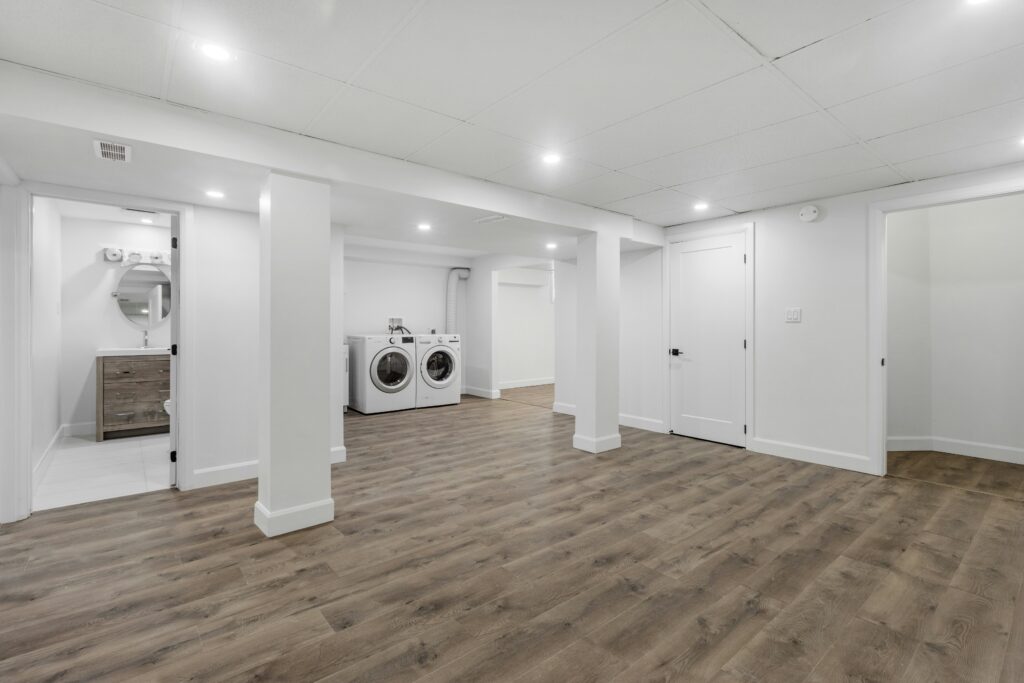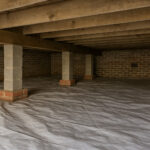A basement DIY renovation can completely change how you use your home. Whether you’re working with a smaller basement or dreaming of a full basement conversion with a home theater or home gym, the possibilities are endless. With some creativity, a few easy DIY projects, and a little planning, your unfinished basement can become a functional living space that adds both comfort and value to your home.
Why Basement DIY Projects Are a Good Idea
Finishing or remodeling your basement is one of the best ways to make your home feel larger without adding square footage. According to the National Association of Realtors, a well-finished basement can increase a home’s value by up to 10–15%. It’s also a good choice for homeowners who want to expand living space, add a guest suite, or create a quiet home office.
Basement projects can vary depending on the age of your home, ceiling height, and existing foundation walls, but even small upgrades like new light fixtures, area rugs, or a fresh coat of paint can make a huge difference.
1. Start with a Plan
Every successful home renovation starts with a plan. Before swinging a hammer, take time to outline your basic steps. The first step is to measure your square foot (or square metres) of available space using a tape measure.
Check local building codes, safety regulations, and construction permits—especially if you plan to install egress windows, run electrical work, or add plumbing for a laundry room or bathroom.
Consider how you’ll use the basement. Popular ideas include:
- Home theater with soundproofing and a dark color palette
- Home gym with shock-resistant flooring and mirrors
- Family room or game room with durable vinyl flooring
- Storage room or workshop with organized shelving
- Home office with bright light color paint and natural lighting
Taking the time to plan these zones ensures the layout fits your family’s lifestyle.
2. Fix Moisture Issues First
No matter how beautiful your design, moisture issues can ruin your basement renovation. Check for potential damage like water stains, musty smells, or efflorescence on concrete walls.
To prevent water problems:
- Inspect and maintain your sump pump.
- Apply a damp proof membrane to the cement floor or foundation walls.
- Seal cracks with concrete screws and hydraulic cement.
- Add a vapor barrier before finishing your basement flooring (like the SMARTCORE Ultra Waterproof Vinyl Plank)
- Consider installing a dehumidifier (like the hOmeLabs 50-Pint Energy Star model ).
If your older house has chronic water issues, hiring professional help or a waterproofing contractor is often a good idea before proceeding.
3. Framing and Insulation Basics
Once dry, it’s time to frame. Use straight pieces of lumber and mark stud placement at every 16-inch mark. Attach the bottom plate to the concrete floor with a masonry drill and concrete screws, and secure the top plate to ceiling joists or floor joists above.
For insulation, use foam insulation boards or fiberglass batts with a built-in vapor barrier. These materials prevent heat loss and condensation, making your basement more energy-efficient.
If your basement has low ceiling height, consider framing slightly closer to the wall and using thinner drywall to save space.
Tool Tip: A reliable nail gun and masonry drill will save you hours when cutting and securing studs.
4. Electrical and Lighting Upgrades
If you’re not a licensed electrician, hire one for electrical work. Proper lighting is crucial in basements since natural light is limited.
Ideas for brightening your space:
- Add recessed light fixtures for general lighting.
- Use floor lamps or LED strip lights for ambiance.
- Choose light color paint to make the space feel bigger.
- Include glass doors or egress windows for lot of natural light.
Smart bulbs (like Philips Hue) can help control mood lighting and energy use.
5. Choose the Right Flooring
The basement floor needs to handle moisture and temperature changes. Avoid carpet in damp areas. Instead, use:
- Vinyl flooring: Durable, waterproof, and stylish.
- Epoxy coatings: Ideal for workshops or laundry rooms.
- Engineered wood: Works well in newer homes with dry basements.
- Area rugs: Add warmth and define zones like a family room or game room.
When installing, always include a vapor barrier underneath to prevent moisture issues.
6. Create a Finished Look with Drywall and Paint
Installing drywall gives your basement walls a finished look. Use additional sheets to cover seams and tape carefully for smooth results.
Once the drywall is up, apply a fresh coat of paint. Light colors can make a smaller basement feel larger, while dark colors add coziness to a home theater. Semi-gloss finishes are best for easy cleaning and durability.
Pro Tip: Paint the ceiling black or charcoal if your ceiling height is low—it hides pipes and ductwork while creating a modern look.
7. Design Your Dream Basement
Here’s where creativity shines. With the basics done, think about how to turn your basement into the perfect space.
Home Office:
Turn one corner into a productive workspace with ergonomic furniture, good lighting, and built-in shelving. Use light colors and a glass door to let in natural light.
Home Gym:
Rubber flooring, mirrors, and a mounted TV can make a basement gym inviting. Add a sump pump check nearby if you’re on the concrete floor, just to monitor drainage.
Home Theater:
A dedicated basement ceiling with acoustic tiles, surround sound, and blackout curtains can transform the room.
Laundry Room:
Install moisture-resistant flooring and a floor drain. Stackable washers and dryers save space, especially in smaller basements.
Family Room or Game Room:
Use area rugs and accent lighting to create a cozy retreat. Add a mini fridge, snack station, or even a glass door to separate zones.
Storage Space:
Maximize every inch with wall-mounted shelving, pegboards, and labeled bins.
With the right design, even an old house can have a basement that looks like it belongs in a newer home.
8. Decorating and Finishing Touches
Decor is where great ideas come to life. Once your basement finishing work is complete, you’ll notice even small touches can make a huge difference.
Some great ideas to consider:
- Add artwork or large mirrors to make the room feel open.
- Use textured area rugs to define different zones.
- Choose neutral tones for walls and pops of color in furniture.
- Install track lighting or dimmable LEDs for flexibility.
- Add plants or greenery to make the air feel fresh and balanced.
You don’t need much time or a big budget to make your basement look like a professional home renovation. Even small changes—like new handles, trim, or accent walls—can bring your dream basement to life.
9. Costs and Expectations
Basement renovations vary by project size and finishes. The most significant expense is typically flooring, followed by insulation and drywall.
Here’s a quick breakdown (U.S. average):
- Framing: $1.50–$3.00 per square foot
- Insulation: $1.25–$2.00 per square foot
- Flooring: $2.50–$6.00 per square foot (vinyl or tile)
- Lighting and Electrical: $1,000–$3,000 depending on layout
Although it’s a significant investment, the long-term payoff—a more comfortable, usable, and better place to live—is worth it.
10. When to Call a Professional
Some DIY jobs, like framing or painting, are perfect for homeowners. But when it comes to electrical work, plumbing, or major structural changes, it’s best to hire professional help.
A licensed electrician ensures your wiring meets safety regulations. Contractors can help with construction permits, foundation walls, and significant changes like adding stairs or removing supports.
11. Maintenance and Long-Term Care
Once your basement is complete, protect your significant investment:
- Run a dehumidifier regularly to manage humidity.
- Inspect your sump pump every few months.
- Watch for cracks or leaks in basement walls.
- Repaint every few years to maintain a finished look.
These small steps prevent potential damage and keep your dream basement in great shape.
In Closing
A basement DIY project might seem like a challenge, but if you follow the basic steps, you’ll be amazed by the transformation. From floor joists to finishing paint, each first step builds momentum toward your home renovation goals.
Whether you’re crafting a cozy family room, creating a personal home gym, or turning that unfinished basement into a modern home theater, these great ideas prove you don’t need much time or a huge budget to make it happen.
So grab your masonry drill, measure twice, and start building your dream basement—one project at a time.




